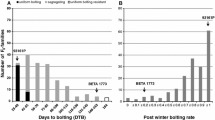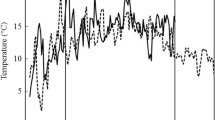Summary
Effects of temperature and daylength on the bolting of a number of B. campestris accessions were investigated both in the open and in the IVT phytotron. From the results it was concluded that low temperature and genotype are the predominant factors with respect to bolting. Daylength has rather limited influence. One cultivar bolted more than 12 weeks earlier at 10 and 14°C than at 18°C. On the other hand some cultivars did not require vernalization at all.
At 14°C and short daylength, depending on genotype, the period of time between sowing and 50% bolting ranged from 8 to 30 weeks. At this temperature the stimulating effect of long day (24 h), depending again on the genotype, ranged from 0 to 4 weeks. The genotypes most resistant to bolting appeared to be the stubble turnips (B. campestris ssp. rapa).
In terms of seed(ling) vernalization at 5°C the cold requirement ranged from 0 to more than 3 weeks, depending on the genotype. The required vernalization periods at 5°C can be used as a criterion in screening for resistance to bolting.
Similar content being viewed by others
References
Anonym., 1976. Jahresbericht 1976. Fachhochschule Weihenstephan: 46.
Bremer A. X., 1934. Chinesischer Kohl oder Selleriekohl (Brassica pekinensis Rubr.) — eine Langtag-pflanze. Gartenbauwissenschaft 9: 324–330.
Elers. B., 1982. Die Wirkung von Temperatur und Tageslänge auf die Blüteninduktion von Chinakohl (Brassica pekinensis). Dissertation Universität Hannover, pp. 68.
Guttormsen G., 1981. Climatic effects in Chinese cabbage for early production. Acta Horticulturae 122: 77–83.
Krug H., & Kling M. F., 1982. Reaktion von Chinakohlpflanzen (Brassica oleracea pekinensis) auf Temperatur- und Lichtbedingungen während der Anzucht. Gartenbauwissenschaft 47: 225–227.
Lorenz O. A., 1946. Response of Chinese cabbage to temperature and photoperiod. Proc. Am. Soc. Hort. Science 47: 309–319.
Zee S. Y., 1975. Agriculture Hong Kong 1: 257–277. Reference: Hort. Abstr. 47 (1977) nos. 9396, 9397, 9398.
Author information
Authors and Affiliations
Rights and permissions
About this article
Cite this article
Van Der Meer, Q.P., Van Dam, R. Determination of the genetic variation in the effect of temperature and daylength on bolting of Brassica campestris L.. Euphytica 33, 591–595 (1984). https://doi.org/10.1007/BF00021162
Received:
Issue Date:
DOI: https://doi.org/10.1007/BF00021162




